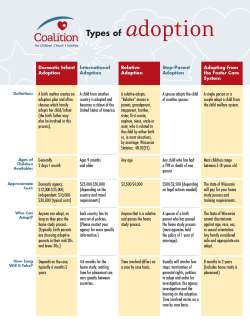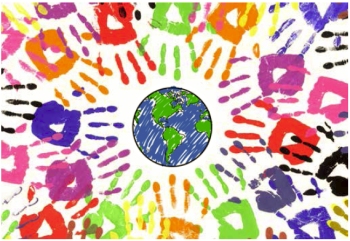Our blog has moved to our new home on the Coalition’s website.
We invite you to join us there and hope you’ll continue to follow our posts and features.

Our blog has moved to our new home on the Coalition’s website.
We invite you to join us there and hope you’ll continue to follow our posts and features.

 It’s World Wide Wednesday! Here’s what’s news in the world of foster care and adoption around the web:
It’s World Wide Wednesday! Here’s what’s news in the world of foster care and adoption around the web:Have news you’d like to share? Please post in our comments!
Inclusion in this post does not imply an endorsement by the Coalition for Children, Youth & Families. The Coalition is not responsible for the content of these resources.
Congratulations! You have made the decision to build your family through adoption. The first step in your adoption journey is to choose an agency. You may be thinking that you want an agency that is licensed by the state, honest, and ethical.
 You may also want to work with staff who is compassionate, patient, efficient, and available when you need them. It’s a good idea to call a few different adoption agencies to see which one is the best fit for you and your family. Here are a few tips to get you started.
You may also want to work with staff who is compassionate, patient, efficient, and available when you need them. It’s a good idea to call a few different adoption agencies to see which one is the best fit for you and your family. Here are a few tips to get you started.
Researching an Agency
Gather as much information as possible about adoption in Wisconsin, adoption agencies, and state requirements. Ask questions like:
Networking and Support Groups
You also might try networking with adoptive parent support groups to find out about the agencies they went to and ask for recommendations. (For a list of support groups, check out the resource section at the end of this tip sheet.)
Support groups and adoption classes are also helpful throughout the whole adoption process, because there is only so much information you can get from agency staff and websites. The real learning comes when you can combine that information with forming relationships with others who are taking the same journey that you are.
Elizabeth Ghilardi, a Wisconsin adoptive parent says, “In the course of our adoption process, we went through 13 weeks of preparation classes; something we initially were not looking forward to, but turned out to be wonderful.”
She goes on to say, “We have kept in touch with many of the families and have gatherings on a regular basis. We have developed an unbelievable support network that is invaluable to our family and the children. Among us, we’ve adopted a total of eight children, with several more pending.”
Once you’ve narrowed down the search for an adoption agency, set up an introductory meeting so you can ask more detailed questions.
Families choose adoption for a variety of reasons and there are a lot of decisions to be made throughout the entire process. One of the first choices to make, is the type of adoption you would like to pursue and what your first steps would be after deciding.
 Below are the three most common types of adoptions and an explanation of what the initial or next step might look like for each one:
Below are the three most common types of adoptions and an explanation of what the initial or next step might look like for each one:
First steps: In Wisconsin, families wanting to pursue a domestic infant adoption would first be required to select a private adoption agency licensed by the State of Wisconsin to complete their adoption home study.
First steps: In Wisconsin, families wanting to pursue an international adoption would first be required to select a private adoption agency licensed by the State of Wisconsin that is able to complete your international adoption home study and be your placing agency or able to work with a placing agency of your choice. (Please note that some private adoption agencies will be able to both complete your home study and be your placing agency, while others will only be able to complete your home study and work with your selected placing agency, based on the country you wish to adopt from.)
First steps: For Wisconsin families who have decided to adopt a child who is in foster care in Wisconsin, your first step would be to contact the regional Department of Children and Families office for your county and register to attend a mandatory two-hour informational meeting with the State Special Needs Adoption Program.
For Wisconsin families who wish to adopt a child who is in foster care in a state other than Wisconsin, your first step would be to connect with a private adoption agency licensed by the State of Wisconsin to complete your adoption home study.
There are several other types of adoption not mentioned above, including, but not limited to, independent adoptions, relative adoptions, stepparent adoptions, and adult adoptions.
For more information about adoption in general, please contact us and ask to speak with a Resource Specialist. You can call us at 1-800-762-8063, locally at 414-475-1246, or reach us via email at info@coalitionforcyf.org. In addition, you can also gather more information from our website, where you can download an informational packet on a specific type of adoption.
When a child enters out-of-home care, there are so many questions and so many things on the to-do list. Ensuring that the child is safe, that he or she has the clothing and hygiene products that are needed, and adjusting to a routine take precedence for all involved. However, understanding the culture a child in foster care is coming from when he or she is placed with a foster parent, is an integral part of welcoming that child into your care, making him or her feel safe, and helping lay the foundation of a successful transition.
 In each of our family lives, there are likely hundreds of little habits or rituals that occur every day without us even thinking about it; they are what make up our family’s “cultural norm.” Children who come into foster care have these same kind of customs, routines, and traditions that were part of the cultural norm in their family of origin. Now, having arrived in your home and with your family, they are faced with having to learn a whole new family culture and figuring out how they fit into it.
In each of our family lives, there are likely hundreds of little habits or rituals that occur every day without us even thinking about it; they are what make up our family’s “cultural norm.” Children who come into foster care have these same kind of customs, routines, and traditions that were part of the cultural norm in their family of origin. Now, having arrived in your home and with your family, they are faced with having to learn a whole new family culture and figuring out how they fit into it.
Getting to know more about a new child’s culture can help you, as a foster parent, understand the child much better. While you learn about and work in ways to honor the child’s experiences, preferences, and routines, you can also teach him or her about your home, your own family’s culture, the values that are important to you, and the customs you honor. You might ask questions such as:
Like in all things that are new or unfamiliar, a new living situation takes time for all to adjust. As foster parents, we know you try very hard to be welcoming and comforting, with a goal of helping children and youth new to your homes make successful transitions. By being flexible and adjusting the culture of your home to accommodate some aspects of the child’s culture, you can give the children or youth in your care time to figure out his or her new surroundings, as well as reduce any possible cultural conflicts.
 It’s World Wide Wednesday! Here’s what’s news in the world of foster care and adoption around the web:
It’s World Wide Wednesday! Here’s what’s news in the world of foster care and adoption around the web:Have news you’d like to share? Please post in our comments!
Inclusion in this post does not imply an endorsement by the Coalition for Children, Youth & Families. The Coalition is not responsible for the content of these resources.
All parents have dreams for their children and are capable of influencing the person that their child becomes. It can be devastating when the dreams that you have for your children cannot be fully realized and the circumstances are beyond your control.
Parenting is not an easy job, but adopting a child often adds another level of challenges. Sometimes children who have been adopted have experienced trauma because of abuse and neglect, multiple placements, or have spent time in an institutionalized care setting.
 The sum of those experiences can lead to challenges down the road that no parent could ever truly anticipate. If can feel like your world is being turned upside down. Adoptive parents are certainly not the only ones who experience these feelings. But it can feel like there is more pressure on you and that you are held to higher expectations as an adoptive parent.
The sum of those experiences can lead to challenges down the road that no parent could ever truly anticipate. If can feel like your world is being turned upside down. Adoptive parents are certainly not the only ones who experience these feelings. But it can feel like there is more pressure on you and that you are held to higher expectations as an adoptive parent.
While you were going through the process of adopting, you had to prove yourself over and over again. First, that you were safe and capable to parent, and then that you and your family would be a good match for your child. Hopes were high and the anticipation of being approved for adoption and growing your family was exciting. When you child is finally in your home and part of your family, it’s such a relief to start to create normalcy for the family.
Families may spend months in the honeymoon period, during which it may feel as if the transition is progressing well. So, it can be surprising to be met with additional hurdles to overcome even several years later, especially when these challenges need to be met outside of your home.
What Can You Do?
Call early and often! When you need help, reach out. When agency staff approved your home study, they didn’t expect you to have all the answers and be able to take care of anything that comes up without assistance. Reaching out for help early on will allow you and your child to take advantage of the most opportunities available to you. Take advantage of the Post Adoption Resource Center in your area. For a list of centers, visit our website, postadoptccyf.org.
If you are working with a therapist or another service provider and there doesn’t seem to be improvement, trust your instincts. Don’t be afraid to ask your therapist for a referral to another provider who has a different style or who uses different techniques.
“From the first day I received foster care placement of my son, then three months old, I sang him ‘You are My Sunshine’ constantly. But I always skipped over the ‘Please don’t take my sunshine  away’ part. I’d fallen in love with him the moment our eyes met, and the thought of letting him go was devastating. But it wasn’t about me. And for his sake, I wished for a happy healthy reunification. But it just wasn’t meant to be. A couple of years passed and I was asked if I’d be willing to adopt. A couple more years passed, and we had an adoption date. I remember every detail of that day. He wore little cuffed corduroys, an oxford shirt, and suede wingtips. I remember family and friends with balloons and cameras at the ready. I remember the judge letting him bang the gavel to finalize his own adoption.
away’ part. I’d fallen in love with him the moment our eyes met, and the thought of letting him go was devastating. But it wasn’t about me. And for his sake, I wished for a happy healthy reunification. But it just wasn’t meant to be. A couple of years passed and I was asked if I’d be willing to adopt. A couple more years passed, and we had an adoption date. I remember every detail of that day. He wore little cuffed corduroys, an oxford shirt, and suede wingtips. I remember family and friends with balloons and cameras at the ready. I remember the judge letting him bang the gavel to finalize his own adoption.
“I remember walking out of Children’s Court on what should have been the happiest day of my life feeling the most unexpected profound sadness.
“How could everyone around us be celebrating? Didn’t they understand the depth of his loss? He no longer “legally” had siblings. His ties to his birth family have been severed. What must they be feeling today? And who could possibly understand the grief I’m feeling?”
Post Adoption Depression. Surely such a thing can’t exist for new adoptive parents? The  finalization of an adoption is the happy ending to what has often been a lengthy, nerve-wracking, emotional roller coaster ride. What possible reason could there be to be depressed when it finally ends?
finalization of an adoption is the happy ending to what has often been a lengthy, nerve-wracking, emotional roller coaster ride. What possible reason could there be to be depressed when it finally ends?
There are a number of reasons that new parents might experience post-adoption depression, including:
Many new adoptive parents might feel reluctant to reach out for help, because most have spent a great deal of time and energy convincing their adoption worker what a great home they can provide for a child. A big step in coping with post-adoption depression is knowing you are not alone and seeking out help. Parenting is hard, for ANY parent. It rarely comes as “naturally” as we imagine it would, for both mothers and fathers.
Some Suggestions for How to Feel Better
Please know that you don’t have to go through your journey along. The Coalition for Children, Youth & Families is here to help and support you and your whole family. For more information on post-adoption and other resources, please contact us.
In the world of adoption and foster care, we often talk about transracial  and transcultural families; those families made up of members representing different ethnic groups or racial backgrounds. But, in truth, while many adoptive families are transracial, all families are transcultural. Even in families where there is no history of foster care or adoption, no two individuals are identical (not even “identical” twins!).
and transcultural families; those families made up of members representing different ethnic groups or racial backgrounds. But, in truth, while many adoptive families are transracial, all families are transcultural. Even in families where there is no history of foster care or adoption, no two individuals are identical (not even “identical” twins!).
There may be overlap, at times, in the way family members think about or respond to something, or how they identify themselves (e.g., “We’re Smiths!”), but each person’s individuality sets them apart.
For families who have adopted, the cultural differences are sometimes subtle, as in the case of a family who has adopted a child of the same race as their own. While they may share the same race, there are often differences in socioeconomic status, ethnic background, or customs and traditions. In other families, those differences may be more apparent, say, for example, when a family has adopted a child of a race or ethnic group that is visibly different from their own. While race, heritage, and ethnicity are all components of culture, there is much more to the definition of culture.
Culture is something that is crafted by and comprised of people. A nation can have a culture, as can a religious group, a business, or a family. Culture can include language, food, art, gender identity, and sexual orientation, among other things. It is the structure that forms how a particular group of people behave or live.
With a definition so broad, it is safe to conclude that culture is all around us. It is in the way we speak, how we approach adversity or happiness, and it helps to define the way we carry ourselves day in and day out. Culture can look different depending on where we are and who we are with. Cultural differences are not always tangible, but they can be. And there may be times when we need to step back to explore how we can understand and embrace differences between our own culture and the culture of another.
So, where do you begin to explore culture with your own children and family members? While there is truly no “right answer,” it’s often recommended to introduce the topic as soon as possible. There are so many points of exploration when it comes to culture, you will likely spend a great deal of time exploring together as a family, in addition to the time you each may spend individually. You could use a variety of methods to explore culture, both your family’s as well as others, including books, movies, food, discussion, visiting familiar spaces and places, creating new traditions, or recreating and incorporating celebrations of other traditions
and holidays.
In the pages of this issue of Partners, we hope you’ll find stories and ideas that will help you and your family begin to explore more about your own cultural roots – as individuals, and as a family unit. Together you can all learn to embrace your individuality, your family culture, and the cultures of others. Be prepared to be surprised, inspired, and to let your
children and family lead and teach you new things. Just as, in the words of Ghandi, “a nation’s culture resides in the hearts and soul of its people,” so does a family’s culture reside in the hearts and souls of each family member – birth, foster, or adopted.
 It’s World Wide Wednesday! Here’s what’s news in the world of foster care and adoption around the web:
It’s World Wide Wednesday! Here’s what’s news in the world of foster care and adoption around the web:Have news you’d like to share? Please post in our comments!
Inclusion in this post does not imply an endorsement by the Coalition for Children, Youth & Families. The Coalition is not responsible for the content of these resources.